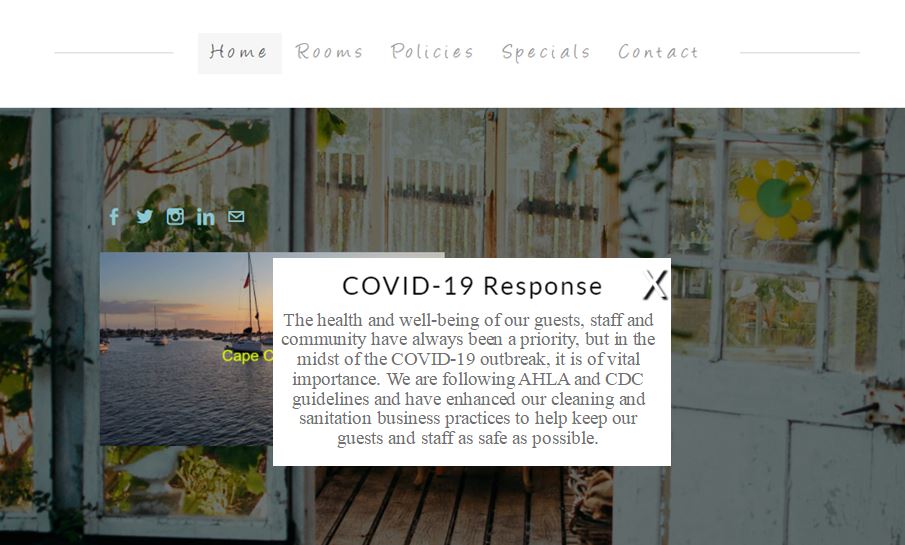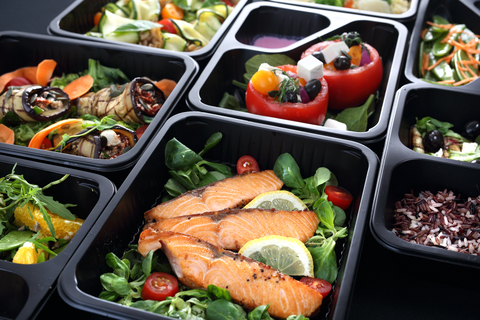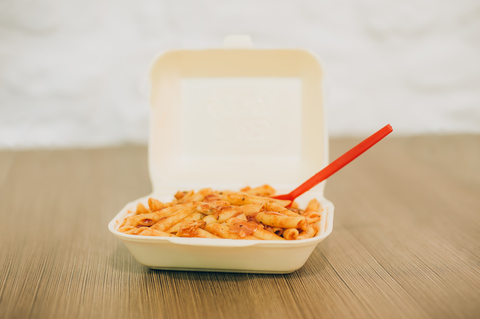by Heather T. | Sep 30, 2020 | Bed and Breakfasts, Lodging, Marketing, Opinion

COVID is an issue with lodging, whether you believe it is a real threat or not. Studies by industry experts have shown that a large majority of people traveling take it seriously and are concerned for the cleanliness and sanitation of a facility.
Recent news highlights that many hotels and homestays as well are not paying attention to standards even though they tout they are.
Where does this leave other legal lodging properties?
It leaves us with a golden opportunity to capture the market of people who are leery of traveling and are very concerned for their safety. While most B&Bs and other lodging properties are making a point somewhere on their websites of mentioning what they are doing to keep guests safe, Some are not. That needs to be fixed, especially if your property is implementing additional safety standards. Your potential guests won’t take the time to inquire, they will just go elsewhere.
 I did want to point out some things I am seeing that can be improved and adjusted with many of the properties that ARE advertising what they are doing. One of the biggest pitfalls I am seeing is the use of pop-up boxes. Pop-up boxes are great, I love pop-ups, BUT not so great for advertising what you are doing for cleaning and safety standards if that is the ONLY place you are letting guests know about it. I am seeing a lot of properties have these boxes, but nowhere else on their site are they talking about the additional steps they are taking.
I did want to point out some things I am seeing that can be improved and adjusted with many of the properties that ARE advertising what they are doing. One of the biggest pitfalls I am seeing is the use of pop-up boxes. Pop-up boxes are great, I love pop-ups, BUT not so great for advertising what you are doing for cleaning and safety standards if that is the ONLY place you are letting guests know about it. I am seeing a lot of properties have these boxes, but nowhere else on their site are they talking about the additional steps they are taking.
As a guest, I may (or may not) bother to read the popup, once it’s closed, it’s gone. What if I have questions? What if I did want to now read it but now can’t do so because I’ve closed the pop-up? I am not going to search and I probably won’t bother to inquire, I’ll go elsewhere. I’d add the pop-up boxes that go on for over a page, the ones with the fancy script that’s impossible to read and the text that’s font size 6 where even with a magnifying glass it’s hard to read as ones that are not helping to properly let guests know what your property is doing. 2 out of every 3 properties with pop-ups only have the information on the pop-up. I’ve been tracking this as I look at dozens of property websites a week.
As a guest, and in normal times I am one frequently, I want to know what a property is doing to keep me safe. If I had to travel now, I would definitely stay in a B&B, with the caveat that I can find easily what the property is doing to keep me (and other guests, and themselves) as safe as possible.
While I do agree we don’t want to go overboard, think of how a guest or potential guest views your site to potentially make a reservation (looking at your Google Analytics would help as well), they land on your home page (and may not scroll down below the fold if that is where you have your safety information listed). Where else if anywhere is your safety information listed? Is it a separate page? Do people know to go there, ie is it under the same drop-down tab as your rooms? Does it have a brief mention on your rooms pages or your policies page or your reservations platform? Have you posted about it on Facebook or other social media? How many times? If it was only once, how about mentioning it every few weeks? Have you taken advantage of Tripadvisors ability to let guests know what you are doing additionally? What about Yelp? What about your Google My Business listings?
If your property is taking the extra time and added expense to enhance your cleaning and safety standards, please let your guests know about it. They want reassurance and you can advertise that you care, but you need to let them know you do in ways they will actually see and remember.
by Heather T. | Sep 22, 2020 | Food, Marketing, Operations, restaurants
 For at least the foreseeable future takeout is probably here to stay for a bit. Love it or hate it as a restaurant owner, having to accept the fact that it is a viable revenue stream is still tough for a lot of owners and managers to adjust to, especially for fine dining restaurants. But as the colder weather approaches it bears a lot of thought to re-address all aspects of takeout.
For at least the foreseeable future takeout is probably here to stay for a bit. Love it or hate it as a restaurant owner, having to accept the fact that it is a viable revenue stream is still tough for a lot of owners and managers to adjust to, especially for fine dining restaurants. But as the colder weather approaches it bears a lot of thought to re-address all aspects of takeout.
I’ve seen many restaurants trying to offer the same menus for in-person dining repurposed to do as takeout, unfortunately for many restaurants, that can be a fatal flaw. Not every menu item adjusts to the takeout scene well, in many cases, reheating it causes overcooking, dryness, or in the case of many fried or sauteed items (like a chicken Marsala with a chicken breast that has been egg and flour dipped and then sauced right before serving) ends up being soggy in transit and may not lend well to reheating.
I’ll be addressing doing a deep dive on the menu itself in the next blog but wanted to address some things regarding takeout containers first.
Questions to ask:
Does it reheat well? And specifically, have you as the Chef or management/owners tried to reheat it in a variety of ways? To take the chicken Marsala as a good example, microwaving the chicken will probably kill it (unless you like rubber chickens), and nuking the sauce will probably break it. Heavy cream doesn’t generally play nice with microwaves. A perfect reheat would probably be the chicken heated up separately in a hot oven with the sauce separate and reheated with the mushrooms in a saucepan and the sauce packed to go separately.
So…Do your customers know how to reheat your food? And if not, how would they know? And if you don’t want to bother considering that, is a rubber chicken with broken sauce doing your restaurant any favors as an example? The number of reviews I have seen since Covid hit mentioning that people were not very happy with their take out for restaurants with normally good to great reviews has not decreased much so it’s still apparently a big problem.
 Next, Is it going to look attractive in the container? While some restaurants may not have the style of dining that plate presentation is high on the priority list, if you have a fine dining restaurant (for example) and you take pride in that, it is a consideration. While I have worked a variety of types of restaurants no matter the level of dining, plate presentation was always important to me, but in some cases, a takeout burger and waffle fries may not have a ton of ways to dress it up but even that can either look attractive when unboxed (or not). I am seeing a huge amount of takeout photos on Instagram and Facebook, so the love affair with taking food photos has not dimmed much. Does this container of pasta look ok? Or could a little garnish improve it? Not sure? Take a few photos with your smart phone yourself? Does it look attractive? Appealing? If you saw it posted on Instagram, would it make you want to get take out from your restaurant?
Next, Is it going to look attractive in the container? While some restaurants may not have the style of dining that plate presentation is high on the priority list, if you have a fine dining restaurant (for example) and you take pride in that, it is a consideration. While I have worked a variety of types of restaurants no matter the level of dining, plate presentation was always important to me, but in some cases, a takeout burger and waffle fries may not have a ton of ways to dress it up but even that can either look attractive when unboxed (or not). I am seeing a huge amount of takeout photos on Instagram and Facebook, so the love affair with taking food photos has not dimmed much. Does this container of pasta look ok? Or could a little garnish improve it? Not sure? Take a few photos with your smart phone yourself? Does it look attractive? Appealing? If you saw it posted on Instagram, would it make you want to get take out from your restaurant?
Are there reheating instructions? A medium-rare steak will not be MR when reheated improperly, does that reflect on the restaurant if customers overcook a dish at home? I would say yes because you can’t expect people to know.
Can customers reheat a dish directly in the container or does it need to be transferred? Is it easy to transfer? Is it messy? Do you loose sauce or ingredients in transferring?
Is the takeout container reusable? To use an example of why that may be a consideration: when we lived in CT, there were two oriental restaurants with similar pricing and fairly comparable food. We ordered from one because A. the containers were not flimsy, the other ones were and we gave up ordering food from them when we had a mess to clean up at home almost every time, and B. the containers were washable and reusable.
Is the takeout container cheap and flimsy? (see above) If you want to go for non-reusable/non-recyclable containers, is the container going to stand up to travel, being lifted out of a bag, and held with one hand (or will it take two and fold over spilling everything everywhere?). We have gotten take out from restaurants who use the round oval aluminum take out containers which while they are fine for light food like salads, load them up with a heavy entrée with sauce and the result can be a mess on the customers end. They might remember the food was good but they will also remember the hassle and inconvenience.
Does the container retain heat well? or remain cold? If I order takeout from a restaurant minutes away I expect the food to remain hot until I get home. And is it protected from anything that is not hot? Is there a layer of cardboard or another item in between. Is your staff giving attention to packing up take out so salads don’t end up directly above or below a hot item? Or cold desserts getting melted by being close to a hot item? Yum wilted warm salad. Delish!
Having a variety of containers on hand for different types of items are highly suggested. And add the price of takeout to your menus, it may only be 15-20 cents per but it can add up very fast if you don’t factor it in and it appears looking at a lot of menus from pre-Covid and current, many restaurants are not. It’s a small adjustment but worth it.
 Consider the Chinese takeout container, high sides, fairly heavy-duty, and well designed, there is a reason this design has been in use for a very long time. It also stacks well and that is an additional factor to think about when evaluating your takeout containers. I’m not saying every restaurant should use these, but merely to consider things that need to factor in choosing containers. Stackability, structure, and compact fit in a bag vs rounds or an assortment of different shaped oblongs. The vast variety of takeout containers available on the market offers a plethora of options, find what works for you instead of purely going by price or looks. The final result is the important part and again if a decent container that fits the bill is 5 cents more then the cheap round, buy it and add it to the menu price, your customers will thank you.
Consider the Chinese takeout container, high sides, fairly heavy-duty, and well designed, there is a reason this design has been in use for a very long time. It also stacks well and that is an additional factor to think about when evaluating your takeout containers. I’m not saying every restaurant should use these, but merely to consider things that need to factor in choosing containers. Stackability, structure, and compact fit in a bag vs rounds or an assortment of different shaped oblongs. The vast variety of takeout containers available on the market offers a plethora of options, find what works for you instead of purely going by price or looks. The final result is the important part and again if a decent container that fits the bill is 5 cents more then the cheap round, buy it and add it to the menu price, your customers will thank you.

 I did want to point out some things I am seeing that can be improved and adjusted with many of the properties that ARE advertising what they are doing. One of the biggest pitfalls I am seeing is the use of pop-up boxes. Pop-up boxes are great, I love pop-ups, BUT not so great for advertising what you are doing for cleaning and safety standards if that is the ONLY place you are letting guests know about it. I am seeing a lot of properties have these boxes, but nowhere else on their site are they talking about the additional steps they are taking.
I did want to point out some things I am seeing that can be improved and adjusted with many of the properties that ARE advertising what they are doing. One of the biggest pitfalls I am seeing is the use of pop-up boxes. Pop-up boxes are great, I love pop-ups, BUT not so great for advertising what you are doing for cleaning and safety standards if that is the ONLY place you are letting guests know about it. I am seeing a lot of properties have these boxes, but nowhere else on their site are they talking about the additional steps they are taking.
 For at least the foreseeable future takeout is probably here to stay for a bit. Love it or hate it as a restaurant owner, having to accept the fact that it is a viable revenue stream is still tough for a lot of owners and managers to adjust to, especially for fine dining restaurants. But as the colder weather approaches it bears a lot of thought to re-address all aspects of takeout.
For at least the foreseeable future takeout is probably here to stay for a bit. Love it or hate it as a restaurant owner, having to accept the fact that it is a viable revenue stream is still tough for a lot of owners and managers to adjust to, especially for fine dining restaurants. But as the colder weather approaches it bears a lot of thought to re-address all aspects of takeout. Next, Is it going to look attractive in the container? While some restaurants may not have the style of dining that plate presentation is high on the priority list, if you have a fine dining restaurant (for example) and you take pride in that, it is a consideration. While I have worked a variety of types of restaurants no matter the level of dining, plate presentation was always important to me, but in some cases, a takeout burger and waffle fries may not have a ton of ways to dress it up but even that can either look attractive when unboxed (or not). I am seeing a huge amount of takeout photos on Instagram and Facebook, so the love affair with taking food photos has not dimmed much. Does this container of pasta look ok? Or could a little garnish improve it? Not sure? Take a few photos with your smart phone yourself? Does it look attractive? Appealing? If you saw it posted on Instagram, would it make you want to get take out from your restaurant?
Next, Is it going to look attractive in the container? While some restaurants may not have the style of dining that plate presentation is high on the priority list, if you have a fine dining restaurant (for example) and you take pride in that, it is a consideration. While I have worked a variety of types of restaurants no matter the level of dining, plate presentation was always important to me, but in some cases, a takeout burger and waffle fries may not have a ton of ways to dress it up but even that can either look attractive when unboxed (or not). I am seeing a huge amount of takeout photos on Instagram and Facebook, so the love affair with taking food photos has not dimmed much. Does this container of pasta look ok? Or could a little garnish improve it? Not sure? Take a few photos with your smart phone yourself? Does it look attractive? Appealing? If you saw it posted on Instagram, would it make you want to get take out from your restaurant?  Consider the Chinese takeout container, high sides, fairly heavy-duty, and well designed, there is a reason this design has been in use for a very long time. It also stacks well and that is an additional factor to think about when evaluating your takeout containers. I’m not saying every restaurant should use these, but merely to consider things that need to factor in choosing containers. Stackability, structure, and compact fit in a bag vs rounds or an assortment of different shaped oblongs. The vast variety of takeout containers available on the market offers a plethora of options, find what works for you instead of purely going by price or looks. The final result is the important part and again if a decent container that fits the bill is 5 cents more then the cheap round, buy it and add it to the menu price, your customers will thank you.
Consider the Chinese takeout container, high sides, fairly heavy-duty, and well designed, there is a reason this design has been in use for a very long time. It also stacks well and that is an additional factor to think about when evaluating your takeout containers. I’m not saying every restaurant should use these, but merely to consider things that need to factor in choosing containers. Stackability, structure, and compact fit in a bag vs rounds or an assortment of different shaped oblongs. The vast variety of takeout containers available on the market offers a plethora of options, find what works for you instead of purely going by price or looks. The final result is the important part and again if a decent container that fits the bill is 5 cents more then the cheap round, buy it and add it to the menu price, your customers will thank you.